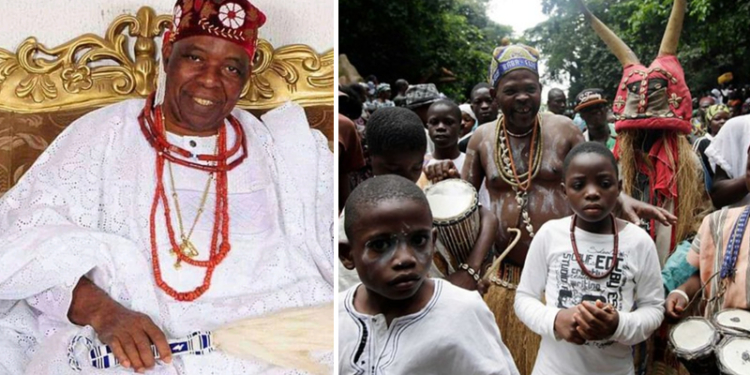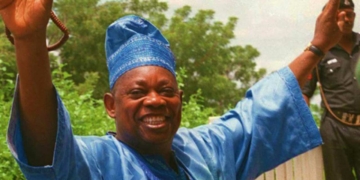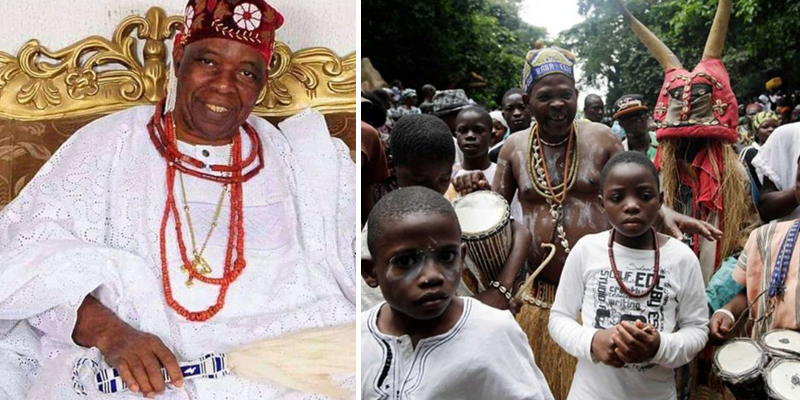There are two versions of story about how Ìjẹ̀sà people come to be. One is traced to Odùduwà and the second is a pure myth.
The first one says: Odùduwà understandably had several children, grand-children, and great grandchildren. I have great cause to believe he had more than seven children as said by Yorùbá histories. Of course, amongst the most known were the king of Ado (Ewì Ado), Ajibọsin (Olòwu) of Òwu, Àlàáfín (Ọ̀ranmiyan) of Ọ̀yọ́, Osomowe of Ondo (from a daughter), the Ọ̀ràngun of Ila, the Aregbajọ of Ìgbàjọ, the Ọwá Ajíbógun-Ajaka of Ilesa.
Note that there were two Àjàka in Yorùbá histories; the ‘second’ Àjàka was the son of Ọ̀ranmiyan, senior brother to Sango (Yorùbá god of thunder). This Àjàka was both the second and fourth Àlàáfín of Ọ̀yọ́….
The story of the last mentioned goes thus:
When Odùduwà became blind from old age he was much depressed in mind from this cause; efforts were put forth to effect his cure, all of which proved fruitless, when a certain man came forward and prescribed for him a sure remedy which among other ingredients contained salt water. He put the case before his children, but none made any effort to procure some for him save Ọwá Ajíbógun, his youngest grandson.
Other narrations say Ọwá was just another unmentioned, direct sons of Odùduwà.
He was a very brave and warlike prince who bore the title of Esinkin amongst the King’s household warriors, a title much close to that of the Kakanfo. He was surnamed Àjàka, i.e., one who fights everywhere, (on account of his procacity) being fond of adventures. He was the only one who volunteered to go and fetch some wherever procurable.
Having been away for many years and not heard of, the aged sire and every one else despaired of his ever coming back; so the Odùduwà divided his property amongst the remaining grown-up children.
After they had all gone and settled in their respective localities, all unexpectedly, the young adventurer turned up with water from the sea. The monarch made use of it as per prescription and regained his sight!
Let me digress, the “certain man” was a king in the then far part of the country. He was both a friend of Odùduwà and the priest who recommended the Òkun (brine) water. He was said to have cordial relationship with the Yorùbá progenitor and enjoyed many trips to Ootu-Ifẹ. So it was “Oore”, of presentday Oore of Mobaland in Èkìtì, that performed the rites processions so that Odùduwà could regain his sight.
Odùduwà was so happy and started calling this great king from Èkìtì land “Oloore Mi” (My benefactor) which later shorten to “OORE”. The king’s title become Oòre, the title of the present Oòre of Moba land in Èkìtì.
The most popular song in Moba:
Àwa Ará ni Moba
Àwa Ará Wa Ni Moba Oh
Ẹ je ka M ẹtọ Ará Wá…”
Back to the rail: the Ìjẹ̀ṣàs who subsequently became Ọwá Ajíbógun’s subjects are termed “Ọmọ Obokún,” children of the brine procurer.
Having distributed all his property he had nothing left for Ọwá Àjàká he therefore gave him a sword lying by his side with leave to attack any of his brothers, and possess himself of their wealth, but should he fail, to retire back to him; hence the appellation “Ọwá Àjàká Onida raharaha” (Owa the ubiquitous fighter, a man with a devastating sword).
A statue of his is at the popular Roundabout front of Ọwá Palace till date of Àjàká holding the legendary sword in one hand and calabash – containing brine he procured – in another.
Ọwá Àjàká chose a spot to settle, a little way from his grandfather. He fought all sides for what later become his land.
This story was first told to me when I was very young by both my mother (of blessed memory) and my half-brother, who is an Ìjẹ̀sà. I later found that most Ìjẹ̀sà – if not all – hold this same version of story with no difference.
The mythical edition: when the nations began to disperse from Ilé-Ifẹ̀, after the historical Ìta Ìjèro conference, and members of the Royal Family were appointed kings and rulers in diversed places, a young and brave scion of the house was appointed the first Ọwá or king over the Ìjẹ̀ṣàs, but that he returned to the Àlàáfín and complained that his territory was too small, and his subjects few, the sire thereupon ordered a large bundle of sticks to be
brought to him, and these sticks he converted into human beings for the Ọwá, in order to increase the number of his subjects. Hence to this day the Ìjẹ̀sàs are often termed by their neighbours “Ọmọ igi” (offspring of sticks!)
This, of course, is a pure myth invented by their more wily neighbours to account for the notorious characteristics of the Ìjẹ̀sàs generally, who are as proverbially deficient in wit as they are remarkably distinguished for brute strength.
HOW THE NAME ‘ÌJẸ̀SÀ’ COME TO BE
As discussed above, Ọwá Ajíbógun was only a conqueror. The “Ijẹ̀sà providence” had aboriginal inhabitants before Ọwá Ajíbógun comquered it, whose story goes down to the earliest period when the Yorùbás have just entered into – and subdued – the country, and the Àlàáfín then resided at Ilé-Ifẹ̀, i.e., prior to the reign of Àlàáfín Sango.
Human sacrifices were common in those days, and in order to have victims ready to hand, it is said that a number of slaves were purchased and located in the district of the presentday Ibokún; there they were tended as cattle, under the care of a certain man called Ọwáju, and from them selections were made from time to time for sacrificial purposes; hence the term Ìjẹ̀sà from Ijẹ Òrìsà (the food of the gods). They are described as stumpy, muscular, and sheepish-looking, with a marked want of inteligence: they never offered any resistance to this system, hence the saying “Ìjẹ̀sà Ọmọ Ọwáju t’ìfẹ́ òpó ikẹ ” (Ìjẹ̀ṣàs children of Ọwáju, subject to much sufferings).
Yet it is evident that the present inhabitants are not all of them the descendants of the aboriginal settlers, the ” food of the gods,” but are largely from the Èkìtìs by admixture; the pure type Ìjẹ̀ṣàs are now and again met with at Iléṣà and neighbourhood.
So, when Ọwá Ajíbógun comquered the Providence, the name Ìjẹ̀sà was given to his people and descendants.
Well, till total abolition of human sacrifice by the British Government in 1893, the Ifẹ̀s, who, far more than any other, were addicted to the practice, always preferred for the purpose to have an Ìjẹ̀sà victim to any other; such sacrifices were considered more acceptable, the victims being the “food of the gods.”
This preference was the cause of more than one threatened rupture between the Ifẹ̀s and their Ìjẹ̀sà Allied Forces during the16 years’ war, and would certainly have developed into open fights, but for the Ìbàdàn army vis-d-vis threatening them both.
While tagging this people as descendants of Èkìtì, Samuel Johnson wrote: It appears that a custom then (in Èkìtì) prevailed of going out hunting for their king three months in the year, and on one such occasion they found game so plentiful in the neighbourhood of Iléṣà (Ilé Oosa – home of the gods) the climate very agreeable, the country well-watered, and the Ìjẹ̀ṣàs there extremely simple, peaceful, and un war-like) probably the remnants and descendants of the old sacrificial victims…whilst at home they endured much oppression from their Ọwá (Ajíbógun Àjàka) that they there and then conceived and carried out the idea of settling on the spot at once, making it their home, and of reducing into subjection the aboriginal inhabitants.
ÌJẸ̀SÀ: THE EARLIEST FORMNATION
Ìjẹ̀sà and Èkìtì being neighbours considered themselves brothers and this made them share some common features. Like best food, dress code and even language (dialect and accent). It’s related that a prominent king of Èkìtì Ẹ̀fọ̀n (Ẹ̀fọ̀n-Aláayè) known as Alààyè Ọ̀gẹ̀gẹ̀ Èpò observed Ìjẹ̀ṣà was not large enough to form a nation like Èkìtì land and chose to carve out nine towns from Èkìtì land to form part of Ìjẹ̀sà land after they (the Ìjẹ̀sà) have failed in their several campaigns against Èkìtì.
Ìjẹ̀sà were not without hitches in their bids towards creation of their own State.
One account says, Ìjẹ̀ṣàs started having different leadership problems after their much war with Ẹ̀fọ̀n Alààyè and some other towns in Èkìtì. Serious Obaship tussles started in the land and the above-discussed Alààyè Ọ̀gẹ̀gẹ̀ was called upon and later enthroned as Ọwá Obokún of Ìjẹ̀sà land.
This is believed to have taken place amidst their Administration.
Samuel Johnson wrote: this fact is fuither shown by the want of homogeneity amongst the principal chiefs of Iléṣà at the present day, for when the town was growing, the settlers did cast about for help; they sought for wiser heads to assist them in the building up and the management
of their country, e.g., from the Ọ̀yọ́s or Yorùbás Proper they had the Ọdọgùn from Irele, the Esawe from Ọ̀ra, the Saloro from Ọ̀yọ́ (the ancient city), and the Sorundi also from the same city — all these came with a large number of followers; from the Ondos, the ‘Loro, and the Salosi from Ijama in the Ondo district ; from the Ekitis, the Arapate from Ara, the Lejoka from Itaje ; and
lastly, the Ogboni from the white cap chiefs of Lagos, the only one privileged to have on his headgear in the presence of the Owa. The Owa himself is as we have seen, a junior member of the royal house of Oyo.
“It is also said that when the town of Ilesa was to be laid out a special messenger was sent to the Àlàáfín to ask for the help of one of the princes to lay out the town on the same plan as the ancient city of Ọ̀yọ. That prince ruled for some years at Iléṣà.”
A source lists Ọwás thus:
Ajibogun(1150-1255)
Awoka Okile(1260-1358)
Obarabaralokun(1360-1459)
Owari(1466-1520)
Owaluse(1522-1526)
Atakunmosa(1526-1546)
Oge(1572-1587)
Biilayi Arere(1588-1590)
Yeye Ladegba(1646-1652)
Yeye Gurogbo(1652-1653)
Biiladu I(1653-1681)
BiiladuII(
Biilaro(1681-1690)
Wayero I(1691-1692)
Wayero II(1692-1693)
Wayero III(1698-1712)
Biilagbayo(1713-1733)
Ori Abejoye(1734-1749)
Biilajagodo(1749-1771)
Biilatutu(1772-1776)
Biilasa(1776-1778)
Akesan(1789-1795)
Biilajara(1796-1803)
Odundun(1804-1814)
Obara(1814-1832)
Gbegba Aje(1832-1846)
Ofokutu(1846-1858)
Aponlese(1858-1867)
Alobe(1867-1868)
Agunlejika I(1868-1869)
Oweweniye(1869-1874)
Bepo(1875-1893)
Alowolodu(1894-1895)
Ajimoko I(1896-1901)
Atayero(1902-1920)
Aromolaran I(1920-1942)
Ajimoko II(1942-1956)
Ogunmokun(1957-1963)Agunlejika II(1966-1981)
Aromolaran II(1982 till present)
ORÍKÌ ÌJẸ̀SÀ
Ọwá Àjàká ògiri gbẹdú,
A bẹ’mọ lórí fi yókù ara ji’ni.
Òtútù bi osun
Mo torí òye mú ọrùn gùn gún wáyé
Ìjẹ̀sà Òṣeré ni yín, ọmọ Onilẹ òbí…..
Nlẹ ọmọ olobi kan ọwọ́ọ́wọ́ tíì wọ́
Nlẹ ọmọ olobi kan ọwọ́ọ̀wọ̀ tíì wọ̀
Ọmọ olobi kan òbí kan, èyí tó jẹ́ t’ẹni a wọ̀ si’ni lapo,
Èyí tí ó jẹ t’ẹni àwọ s’okiti ẹgan; ọmọ ẹranko a rí òun mú jẹ….
Mo torí òye mọ bá wọn mú ọrùn gungun w’aye…
Mo mon ibi tí wọn gbé ń kí Ìjẹ̀sà tíì fi fún’ní lobi tó gbó
Mo mọ ibi tí wọn gbé ń pè Ọmọ Ọwá tíì fi yọ kòndo ti’ni
Ìjẹ̀sà kéékèèké bí ẹni fi làáli lè ọmọ lọ́wọ́
Mo mọ ibi tí wọn gbé ń kí bàbà bába yín tíì fi ilé Isẹ gba ni lẹ́nu.
Tí wọn ba sọ pe, “Tẹ́nì gbọla Oseere, Ọmọ Olobí seje,
Ọmọ olobi sẹfa.
Nlẹ Oseere ọmọ olobi mẹ́rìndínlógún”
Wọn a má fún’ní lowo, wọn a má fún’ní loúnjẹ
Tí wọn ba sọ bayi na, “ọdún burú, Òṣeré ọmọ olobi forú se
Ọmọ porokiti onidẹ,
Ọmọ olobi kan a jẹ fọwọ́ kan wúńdíá lọmú”
Wọn a man fi ilé Isẹ, wọn a man fi gba’ni lẹ́nu
Tí wọn ba wa sọpe, “Ìjẹ̀ṣà ó rídìí isana,
Ilé ni ẹrú Ọwá tí ń mú na lóko.
Anu má dáro a mú arúgbó tá giẹgiẹ”
Wọn a má yọ kòndo, wọn a sì má yọ kumọ
Ọlá kò sì lọ nípò bàbà rẹ….
T’ẹ́nìgbọla ọmọ olobi f’oru se….
Tẹ́nì gbọla tí mo gbé odò kalẹ nínú ilé Mòye,
Tí mo gbé ọtí kalẹ má béèrè ọwẹ.
Òkèèkè l’asọ wọn lóde Ìgbàjọ
Gbọdọkiẹmi l’asọ àwọn Ìjẹ̀ṣà,
Èyí tó bá rí l’ọja ni ó ra fún mi wá kín rí òun jo ṣẹ̀ṣẹ̀ ni korò nigbo Olooye
Óò man jó lóye ju ìran Ìjẹ̀sà.
Ìjẹ̀sà mo dú, Ọmọ apànada
Ògún t’ori kaun, ogún ja Haúsá.
Ogun t’ori òbí, ogún ja Ìjẹ̀sà.
N’ijọ ogún ja Hausa n’ijọ náà ni ogún kò kaun
Ogun ja Ìjẹ̀sà, ogún ó k’obi lọ.
Ń ó lè kìí àgbà Ìjẹ̀sà kín má gb’obi tó’gbó,
Ogun làálu, mo fẹ́ gb’obi lọ́wọ́ rẹ,
Ọmọ ogún tíì ń gbà’ni ti n gbàgba ẹni.
Ìjẹ̀sà Abẹni, Ọmọ Onilẹ òbí
Ìjẹ̀sà ó ri’di ìṣàná;
Wọn ní Ilé ni ẹrú Ọwá tí ń mu’na r’oko
Ìjẹ̀sà dúdú l’ẹ̀gbọn; pupa l’aburo
Dúdú ni mo kọ́kọ́ fi ọmọ fun
Níjọ inú bí dúdú, ó na ọmọ tí mo bi.
Mo yà’a gbà ọmọ lọ́wọ́ dúdú mo fi fún pupa.
Ìran Ìjẹ̀sà nii sìn tolotolo;
Ẹrú bàbà yín ní sìn pẹpẹyẹ…
Ọmọ olókùn Ado, ọmọ olodo idẹ̀…
Àkàrà kan rúgúdù l’ ẹ̀nmu s’oro l’okiti Ẹ̀fọ̀n
Mo ri ọlá, mo kélè jẹ́gbẹ ni mòye
Ọmọ pankẹrẹ l’ẹn mú d’ùbu Ọsun, létí Iyemoja
Ẹrú làá gba’ja ọna lẹkun Ìjẹ̀sà.
Èèyàn ti ń lọ Ikirun Àgùnbẹ,
Wọn ní kẹ má wulẹ̀ mú ọkọ dání,
Àpáta ńlá tí dálẹ ó dà’kirun.
O torí bàbà oníkálukú, wọn mú oṣù tí wọn pẹsẹ wolu
O kan bàbà mi Ìjẹ̀sà Abẹni, Ọmọ Onilẹ òbí
O mú oṣù tí ẹ náà tán
O mu fún Abiọdun, Àlàáfín Ọ̀yọ́.
Bàbá mú oṣù kan gudugba,
O fi fún Bàbá mi, Òṣeré ọmọ Onilẹ òbí
Ọmọ l’ọ́mọ̀ alakukọ gágárà tíì jí kọ́ l’odo ọna n’ijọsi
Oko l’ẹ̀ nmu se’le;
Ọ̀kọ̀ọ̀kan ni’la jo;
Ọ̀kọ̀ọ̀kan la ń lu Ọkẹẹ̀kẹ̀ẹ̀
Ọkẹẹ̀kẹ̀ẹ̀ jọ, n ó lọ rèé fẹ’binrin
Ọmọ as’aale jẹjẹ bí ẹni ó r’obinrin ri;
Aya ṣetán, aya kún’le Ọwá piitimu
Gbaagbẹji, Ọmọ arọ l’Òkìtì Ẹ̀fọ̀n
Fully Compiled by Jimoh Taofik Adekunle (Jimson Jaat Taofik)
The MAD Writer: Pen Priest
Facebook: Jimoh Taofik Adekunle
Twitter: @jimsonjaat01
Gmail: deskofinsanity96@gmail.com
Phone: 08144510532





Discussion about this post